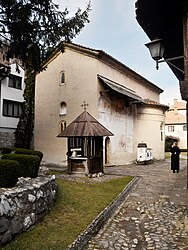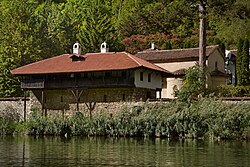Monastery of St. Nicholas of Rošci
| Monastery of St. Nicholas of Rošci | |
|---|---|
Манастир Никоље Кабларско | |
| Years built | 16th century |
The Monastery of St. Nicholas of Rošci (Serbian Cyrillic: Манастир Никоље Кабларско Serbian Latin: Manastir Nikolje Kablarsko), also known as St. Nicholas Monastery in Kablar, is a Serbian Orthodox monastery located in Rošci, in Moravica district and on the territory of City of Čačak, in the west of Serbia. Dedicated to Saint Nicholas,[1] it is one of the ten monasteries of the Ovčar-Kablar gorge, which for this reason is nicknamed the Serbian Mount Athos,[2] It is home to a community of nuns.[1] It is included in the list of Cultural Monuments of Great Importance of the Republic of Serbia (identifier SK 371).[3][4][5][6]

Location
The monastery is located at the foot of Kablar, on the left bank of the West Morava, in the territory of the village of Rošci.
History
The monastery was founded toward the end of the
Architecture and frescoes
Modest in size, the church is built on a Trefoil plan; it lacks dome.[5][6] Its walls are made of crushed stone and the decoration of the facades is limited to reliefs on the window sills; the konak was restored again in 2006.[5][6]
-
The western facade and the southern facade.
-
Detail of the bedside.
-
Detail of a window.
According to an inscription, it was decorated with
-
Frescoes in the church.
-
Other fresco.
-
Another fresco.
Manuscripts

The monastery, which housed a copyist's workshop during the Ottoman occupation of Serbia,[5][6] has a collection of manuscripts. The famous
Old konak
The old konak, located along the river and south of the church, was built during the time of Prince Miloš; it is considered to be one of the most beautiful buildings of traditional style of this era.[5][6]
It consists of a ground floor and a first floor.
-
The old konak.
-
Another view of the old konak.
Restorations
The monastery underwent a major renovation during the reign of Prince Miloš in 1817 and forty years later.[5][6] The church was renovated and plastered on the outside and the apses were adorned with a series of blind plaster niche.[5][6]
Restoration work was carried out on the konak in 1955–1956 and 1975, on the architecture of the church between 1956 and 1960 then in 1975 and on the frescoes in 1965 and 1980.[5][6]
See also
References
- ^ a b Manastiri site (ed.). "Manastir Nikolje sa crkvom Svetom Nikoli". www.manastiri.rs (in Serbian). Retrieved November 2, 2020.
- ^ D. Šćekić (1 September 2006). "Srpska sveta gora". www.politika.rs (in Serbian). Politika. Retrieved November 2, 2020.
- ^ Site of the Institute for the Protection of Heritage of the Republic of Serbia (ed.). "Cultural monuments of great importance" (xls). www.heritage.gov.rs (in Serbian). Retrieved November 2, 2020.
- ^ Site of the Institute for the protection of the heritage of Kraljevo (ed.). "Čačak". zzskv.rs (in Serbian). Retrieved November 2, 2020.
- ^ a b c d e f g h i j k l m n Serbian Academy of Sciences and Arts (ed.). "Manastir Nikolje Kablarsko". spomenicikulture.mi.sanu.ac.rs (in Serbian). Retrieved November 2, 2020.
- ^ a b c d e f g h i j k l m Site of the Serbian Cultural Heritage Search Navigator (ed.). "Manastir Nikolje". kultura.rs (in Serbian). Retrieved November 2, 2020.
- ^ a b c Danas, ed. (December 14, 2015). "Manastir Nikolje: Tamo gde se nikad nije vatra gasila". www.danas.rs (in Serbian). Retrieved November 3, 2020.
- ^ a b Site of Balkan Vernacular Architecture (BVA) (ed.). "Konak, Manastir Svete Nikolje Kablarsko, view from courtyard". www.balkanarchitecture.org. Retrieved November 3, 2020.








